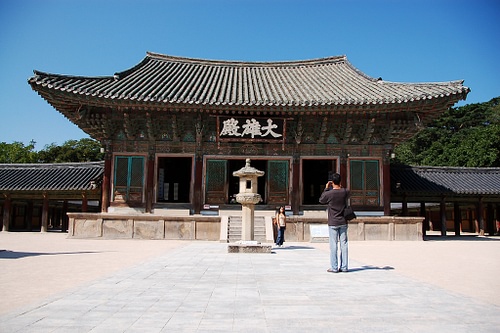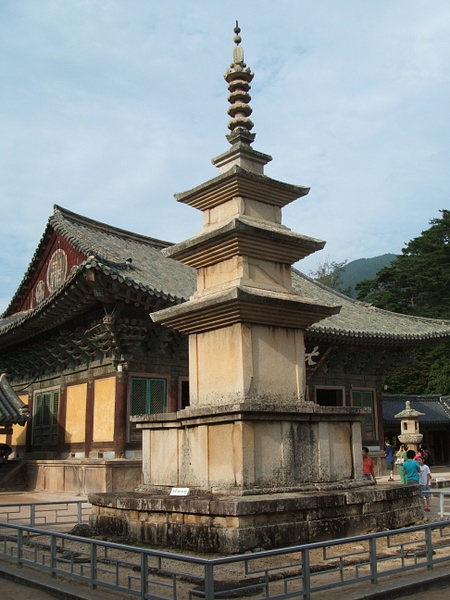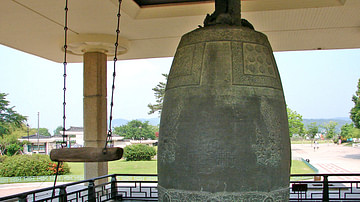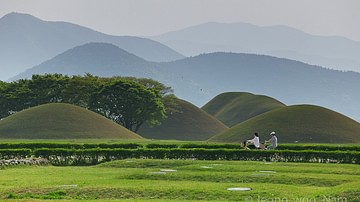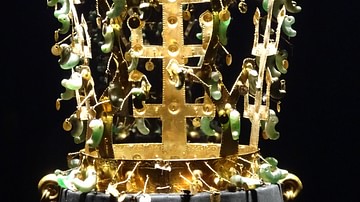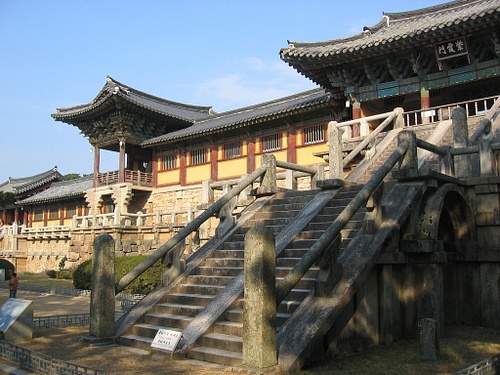
The Bulguksa Temple (aka Pulguk-sa Temple or 'Temple of the Buddha Land') was built in the 8th century CE on the wooded slopes of Mt. Tohamsan at the ancient Silla capital of Geumseong (modern Gyeongju, South Korea). The Buddhist temple, after suffering a destructive fire, now stands restored but is only a fraction of its original size. The temple and nearby Seokguram Grotto with its huge seated Buddha statue is recognised by UNESCO as a World Heritage Site.
The temple was built on an earlier foundation set when the territory was controlled by the Baekje (Paekje) kingdom (18 BCE - 660 CE). The chief architect of Bulguksa is traditionally credited as Kim Dae-seong (700-774 CE), the Chief Minister or chungsi of the Unified Silla kingdom which ruled Korea from 668 to 935 CE. The period saw a great deal of Buddhist architecture spring up across Korea, but Bulguksa is widely regarded as one of the finest complexes dedicated to the official state religion of Korea.
The Land of Buddha
The complex, as its name suggests, was designed to represent the land of Buddha, that is paradise. For this reason, there are three principal zones: Birojeon (Vairocana Buddha Hall), Daeungjeon (Hall of Great Enlightenment and main temple), and Geungnakjeon (Hall of Supreme Bliss). The halls, constructed in wood and stone with tiled roofs, are each built on a raised stone terrace.
This architectural representation of paradise, which rises symmetrically from a lotus lake, is symbolically entered via two stone bridges and a large staircase, reminding the visitor that they are leaving the earthly realm behind them and stepping into the sacred realm of Buddha. The entrance gate, known as the Mauve Mist Gate (Chaha-mun) is approached by the 'cloud bridge' staircase. The visitor must climb a lower flight of steps known as the Bridge of White Clouds (Paekun-gyo) and then an upper flight with the name Bridge of Azure Clouds (Chongun-gyo). Besides the three large halls, the complex included floating pavilions and living quarters for monks as it also functioned as a monastery. The combined floor space of all of these structures was said to cover 2,000 kan (one kan being the space within four columns).The temple complex was so large and built with such precise mathematical and geometrical considerations that it took almost 40 years to complete, beginning with the traditional start date of 751 CE and finishing in 790 CE.
Dabotap & Seokgatap Pagodas
Although the original wooden buildings of Bulguksa have long since disappeared the temple does have two surviving stone pagodas – the Dabotap (Tabo-tap or 'Pagoda of Many Treasures') and Seokgatap (Sokka-tao or 'Pagoda that Casts No Shadow') – which both traditionally date 751 CE. Stone pagodas are Korea's unique contribution to Buddhist architecture, and they usually stood as a pair in a courtyard in front of the main temple hall, as was the case with these two at Bulguksa which stand before the Daeungjeon Hall.
The Dabotap pagoda, which represents the Dabo Buddha, is the more complex of the two and stands at the east side. It has a square base with a columned pavilion accessed by a short flight of stairs on each of the four sides. The pavilion may once have housed an image of Buddha and at the top of the western stairs is a stone lion, a design which may originally have been repeated on the other three staircases. Above are multiple octagonal levels with columns in the form of bamboo stalks and then circular, flower-shaped layers at the top. The Seokgatap, on the west side and representing Sakyamuni Buddha, is a simpler affair and has a large square base and then three prominent square levels topped by a thin spire. Excavation around the Seokgatap pagoda in 1966 CE brought to light a sarira (reliquary casket) containing the world's oldest woodblock-printed document, a copy of the Dharani sutra.
Later History & Restoration
Many of the temple complex's wooden buildings were, unfortunately, destroyed during the Japanese invasions known as the Imjin Wars (1592-8 CE). Restorations were made over the centuries, often based on ancient descriptions, but the complex is much smaller than the original. The two pagodas and two of the bridges all feature on the official list of National Treasures of Korea.
Seokguram Grotto
Nearby Bulguksa, set into the upper south-eastern slopes of the Tohamsan mountain, is the Seokguram Grotto (Sokkuram). This Buddhist cave temple was constructed as an artificial grotto between 751 and 774 CE, again by Kim Dae-seong. The circular inner chamber has a domed roof and a white granite statue of the Sakyamuni Buddha which is 3.45 metres high. The walls of the grotto are decorated with 41 figure sculptures set in niches. Seokguram features at position no. 24 on the official state list of National Treasures of Korea.
This content was made possible with generous support from the British Korean Society.
